*Disclaimer: I am not a dietician, nor a nutritionist. I am just someone who has done research over much of my life in order to feed my body in a healthy manner.
*Disclaimer #2: Note that in each “CNN’s take” section, I’ve used words and concepts from their article. You can find all of the original content via this link. I also used their photos so you can see what they look like.
After seeing some of my Facebook friends share one of CNN’s recent articles, my senses perked. Before even reading the title: “13 Comfort Foods To Boost Weight Loss”, I saw a big picture of a piece of pumpkin pie with a dollop of whipped cream on top. What secrets does CNN have that suddenly allow us to eat all of these tasty comfort foods without risk of weight gain?

The answer: THEY DON’T HAVE ANY SECRETS!
In fact, they are disappointingly misleading in this post! Their newly discovered “secrets” can potentially cause the “I want to lose weight, but I don’t have to willpower to do it,” and the “I have no idea what to eat to lose weight” members of society to give themselves an excuse to eat whatever they want under the guise that their favorite, sugar-filled foods will burn that extra flub. It must be true, because it’s on the Internet, right?! Although, I do have to mention that their post was actually a copy of Health.com’s article, so you decide who the blame goes to.
Note: CNN and Health.com are organizations that do their research! The issue is not that what they are saying is false, it is that their omissions can mislead those who aren’t as well-versed in nutrition.
The problem I have with this article is that the author seems to determine the healthiness of the dish or item based on one ingredient in it or one aspect to it. They give very few instructions on how to use that ingredient to reap the highest benefit in terms of weight loss. If we always based the healthiness of a meal on one ingredient, nutrition would be a free-for-all! We’d be able to add pizza on whole wheat dough to the “Weigh Loss Foods” list, even though it might also have pepperoni, sausage, and double cheese. We’d also add jalapeño poppers to the list. Jalapeños are good for you, right?
OK, let’s examine CNN’s/Health.com’s list a bit closer:
Hot Chocolate

CNN’s take: Cocoa is “packed with antioxidants, which reduce your levels of cortisol, a stress hormone that causes your body to cling to belly fat.”
The real deal: It’s true that some chocolate has very high antioxidant levels. However, it has been shown that dark chocolate and cocoa powder are the forms of chocolate that you want to tend toward when you reach for your sweet antioxidant drink, as white and milk chocolate are not as fruitful. (WebMD) Also, it’s important to note that if you choose to make your high-antioxidant chocolate into the sugary hot chocolate drink, you might actually be gaining weight due to the high caloric content. CNN’s article didn’t mention that grabbing your local brand of Hot Cocoa with dried marshmallows might not have the weight loss results you might be looking for.
They recommend this recipe: Mexican hot chocolate <— This is great for a treat. Use non-fat milk, soy milk, or almond milk, and try to use an organic, unsweetened cocoa to eliminate the chance of having toxins or lead in your cocoa (see The World’s Healthiest Foods).
Here are some unsweetened, organic cocoas. This is not an all-inclusive list–there are other brands out there!
- Rapunzel Organic Cocoa Powder
- Sunfood Raw, Organic Cacao Powder
- Navitas Organic Cacao Powder Raw Chocolate Powder
- Dagoba Organic Chocolate Cacao Powder

Collard Greens
CNN’s take: It is low in calories, has more than your daily-doses of vitamins A and K, and it contains a good amount of fiber.
The real deal: That all sounds great as long as you keep the fatty, processed bacon/lard/vegetable oil out of it, as well as keep the butter additions low. This recipe that they posted looks great, but the problem is that they don’t articulate these restrictions that can make-or-break the dish in terms of fat and calorie content.
Chicken Noodle Soup
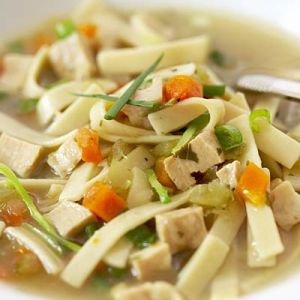
CNN’s take: The article shares: “People who eat a broth- or vegetable-based soup before their meal consume fewer calories overall,” says Rania Batayneh, nutritionist and author of “The One One One Diet.”
They also mention that many chicken noodle soups have elements that increase your metabolic rate.
The real deal: I think they got this one right! Of course, there are ways to keep your Chicken Noodle Soup more healthy. Ideas include using little-to-no oil when cooking the chicken, using only white chicken meat, adding even more vegetables than your recipe calls for, and using whole wheat noodles.
They recommend this recipe. It looks great! Sticking to white meat will be your best bet in terms of keeping the fat content low. Also, use a whole wheat pasta, a brown rice, or a barley instead of a higher-processed grain.
Coffee

CNN’s take: Coffee has chlorogenic acid (CGA), which helps your body burn fat for energy and that it can also help muscle recovery post-workout.
The real deal: The article doesn’t mention limiting your intake. Should I drink coffee all day so I can keep burning and burning and burning fat until it all disappears? Not exactly. The Mayo Clinic and Men’s Journal recommend drinking 2-4 cups a day, listing negative side-effects to drinking too much.
Health.com recommends this Skinny Girl recipe, which looks to me like a great alternative for those of us who LOVE lattes, mochas, macchiatos, or any other flavored coffee combination.
Here’s another caffeine-related resource for you: Health.com: 12 surprising sources of caffeine
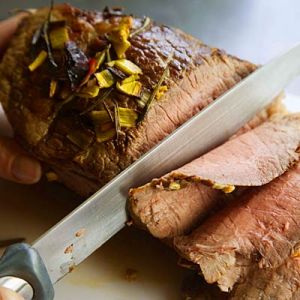
Pot roast
CNN’s take: It has protein, and because protein takes more effort for your body to break down, it results in a higher calorie burn. It also keeps you fuller for a longer period of time, because it stays in your body longer.
The real deal: While there is scientific evidence to back-up the article’s suggestion, why do they recommend pot roast instead of a lean meat, such as lean ground turkey or chicken breast? There are even vegetables that contain a good amount of protein (see a list here). While pot roast might have a higher protein content per ounce, it also has a much higher fat content. It seems logical to rid yourself of the fat and go with a leaner protein source if you really want to lose weight. The Institute of Medicine recommends 0.8 grams of protein per day per 1 kilogram of body weight for adults. Calculate how much protein you should consume a day.
Oatmeal
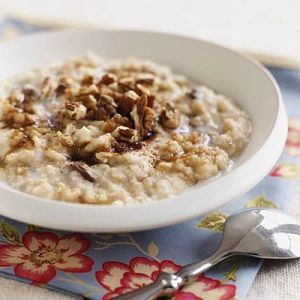
CNN’s take: The combination of fiber and protein that oatmeal contains slows carbohydrate digestion and keeps you fuller for longer. They recommend steel-cut oatmeal, because it has a lower Glycemic Index score.
The real deal: Oats ARE a great addition to a healthy diet, as long as they are whole grain. Here are some facts about oats from the Whole Grains Council (didn’t know the organization existed, did you?) In the article, CNN referenced a Steel Cut Oats recipe that contains whipped cream and brown sugar. While you can use these items sparingly, try other options, such as dried fruit, fresh fruit, sliced almonds, and honey.
Have you seen these Refrigerator Oatmeal recipes by The Yummy Life? They are easy to prepare, and delicious!

Roasted carrots
CNN’s take: Carrots are full of water and fiber, which fill you up quickly, and if they are roasted at 104 degrees, their antioxidant content rises to three times that of raw carrots.
CNN recommends this recipe: Roasted baby carrots with fresh thyme
The real deal: No complaints here. Just make sure you don’t load them up with butter, oil, or sugar.
Red wine

CNN’s take: It’s healthy for the heart, and contains an antioxidant that prohibits the production of fat cells. Lastly, they say a substance in red wine, called calcium pyruvate, helps fat cells burn more energy.
Health.com: The best red wines under $10
The real deal: Good job! They finally mentioned a limit to consumption on this one. They recommend sticking to just one 6-ounce glass (150 calories). Totally acceptable. Thanks, CNN and Health.com!
Pumpkin
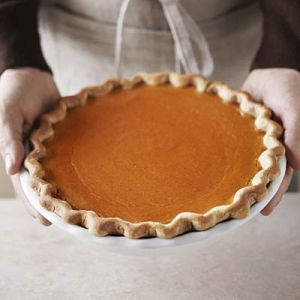
CNN’s take: It is low-calorie and has 3 grams of fiber. It also contains an antioxidant that fights fat storage. The article includes a link of best and worst pumpkin-flavored products, which is helpful, but requires you to buy from a specific brand or retailer and doesn’t actually educate the reader on how to make a good decision when baking, cooking, or consuming non-specialty pumpkin products.
The real deal: This piece of the article is especially misleading. Judging by the picture and the text, it seems as though they are saying that a pumpkin pie indulgence might actually help with fat burn. The only sentence that might be interpreted as otherwise is the first sentence that says, “Don’t let the pie fool you.” However, without giving the do’s and don’ts of how to use pumpkin in a healthy way, this can be misleading to readers. So, let’s think of some basic principles to keeping your pumpkin recipes healthier:
Soups: eliminate cream
Desserts: do the basic substitutions, such as replacing some or all of the sugar with honey and or decreasing the sugar content, and replacing oil with unsweetened applesauce.
Breads: see above and replace each egg with half a banana (doing this will add a banana flavor, as well, so be prepared for that).
Here are some healthier pumpkin recipes:
Pumpkin Muffins: Vegan and Healthy
Healthy Butternut Squash and Apple Soup (replace the squash with pumpkin)
Low Fat Baked Pumpkin Pasta (using whole wheat noodles, using reduced fat cottage cheese instead of ricotta, and eliminating or reducing the parmesan)
Chili
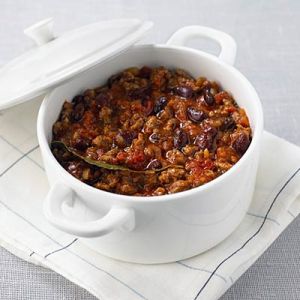
CNN’s take: The fiber and protein in many of the traditional ingredients cause fulness. In addition, spices can “increase your daily calorie burn by about 50 calories”, which “equals 5 pounds lost over a single year.”
The real deal: REALLY?! Their post makes it seem like if you eat chili, you can actually LOSE 5 pounds over the course of a year. That’s absolutely, ridiculously misleading! I go to a Fall Chili Social every year. From my experiences, I know there are many different types of chili. We’ve had very spicy, greasy chili with ground beef, sweet chili made with brown sugar, and white ground turkey chili with a lot of vegetables in it. Remember that not all chili is created equal! If you are looking to reap the benefits CNN mentions in their article without adding a ton of fat and calories, try using ground turkey, adding in several peppers and/or spices, adding in several other vegetables of choice (carrots, celery, onions, green peppers, etc.), eliminating cream, eliminating sugar, and using a very limited amount of oil in preparation.
They recommend this recipe: Chili from scratch <— use lean ground turkey and use only 1 tablespoon of EVOO in place of the vegetable oil. Feel free to add more veggies!
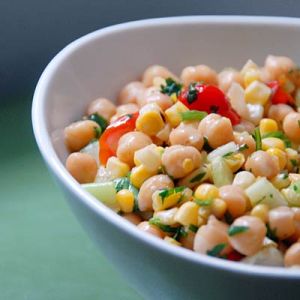
Chickpeas
CNN’s take: Due to their fiber and protein content, garbanzo beans help stabilize your blood sugar and they make you feel fuller faster. Their unsaturated fat content encourage lower body mass indexes and less fat around the abdomen.
The real deal: This is a good piece of the post. Just remember that adding chickpeas to any dish doesn’t make it healthy. Keep the oils, butters, sugars, and fats low if you really want to reap the benefits of these little beans.
They recommend this recipe: Cumin-spiced chickpeas <— Use a small amount of extra virgin olive oil in place of vegetable oil
Roasted potatoes

CNN’s take: Potatoes have a chemical, called allicin, that fights inflammation, reducing mid-sections. They are also shown to be more satisfying in smaller quantities than many other foods.
The real deal: Really, CNN? If I didn’t know better, I’d eat vats of potatoes in different styles so MY waistline could be reduced a LOT! Some of my choices might be roasted potatoes covered with melted butter and cheese, mashed roasted potatoes with cream cheese and sour cream mixed in, roasted potatoes opened up with a tablespoon of butter/sour cream and sprinkled with cheese… YES! Thanks, CNN!
Although potatoes shouldn’t get the bad rap they have in terms of weight gain, let’s be a little more specific about how we should eat them. Keep the butters, sour creams, cream cheeses, sugars, etc. LOW! It’s hard to enjoy a potato without some other goodness included, so try reduced fat cheeses, reduced fat butters, salt and pepper, and other herbs. My favorite way to prepare them would be to slice them raw, coat them with a very minimal amount of olive oil, lay them in one layer, flat on a baking sheet, and sprinkle them with a little salt, pepper, and rosemary. Broil them on High for about 10 minutes (keep an eye on them to ensure they don’t burn). Yum!
They recommend this recipe: Garlicky roasted potatoes with herbs <— This recipe looks great. Just decrease the amount of olive oil to cut some unneeded calories!
If you want to learn a LOT about potatoes, visit Precision Nutrition.
Mashed sweet potatoes
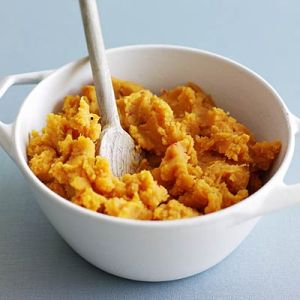
CNN’s take: The high carotenoid and CGA content in sweet potatoes can “prevent sugar from getting stored around your waistline as fat.” Also, the high-fiber content makes you feel fuller quicker and slows digestion.
The real deal: Sweet potatoes, like white potatoes, are not inherently bad for you. However, pay attention to how you prepare them and what you eat them with. The same “rules” that apply to eating healthy versions of white potatoes apply to sweet potatoes.
They recommend this recipe: Maple-pecan sweet potato mash <— This recipe contains a LOT of maple syrup. Cut it down or eliminate it and enjoy the flavor of the natural potato with fresh herbs without the heavy sugar content.
Here’s Precision Nutrition’s take on sweet vs. regular potatoes
———————–
The point is, sometimes we get a partial story. I need to constantly remind myself to use my own brain to assess everything I read. Please do this, also, with what I write! Comment if you disagree, comment if you agree! I write for conversation and for growth on both my end and yours.
Eat up!

I like your post and totally agree with all the misinformation that gets spread around the holidays! But what is with all the low fat and reduced fat options? The “eating fat, makes you fat” myth from the 90s has been debunked. Portion size (I.e. over all calorie intake) and quality of food definitely comes into play, but smaller portions of full fat dairy products and meats with saturated fats have been proven healthier. Thoughts?
Thank you for your comment, Bethany!
I DEFINITELY agree that reduced-fat options are not usually good options when you are talking about desserts, because they often have higher calories and sugar. That might be where the misconception that lower fat dairy and meat is not as good for you. Here is the AHA’s recommendation for diary consumption: http://www.heart.org/HEARTORG/GettingHealthy/NutritionCenter/Milk-Products_UCM_306008_Article.jsp
If you trust WebMD, look at this article: http://www.webmd.com/diet/features/6-reasons-to-get-your-diary.
Here’s another great resource from the Australian Heart Foundation: http://www.heartfoundation.org.au/healthy-eating/mums-united/articles/Pages/fat-milk-dairy.aspx
As far as meat, the American Heart Association recommends choosing a lower fat meat or legume over red meat, but does mention that red meats-in smaller quantities-is ok: http://www.heart.org/HEARTORG/GettingHealthy/WeightManagement/LosingWeight/Eat-More-Chicken-Fish-and-Beans-than-Red-Meat_UCM_320278_Article.jsp
Also, know that I’m not saying that all fat is bad. Fats keep your body functioning as it should. This is why “Fat” is on the food pyramid. However, reducing unnecessary fats can help with weight loss and help the heart. All that said, this is not a post on how to create a well-balanced diet, but focuses on misrepresentations in this article and how to make things less caloric and have a lower fat content if your focus is on losing weight.
As you know, there are good fats and not-so-good fats. In this article (http://www.mayoclinic.org/fat/ART-20045550?pg=2), the Mayo Clinic Staff talks about choosing the right fats. It also discusses how to choose the right amount of fat for you if you are interested in it.
Thanks for bringing this up! Although I didn’t anticipate a “fat” discussion, it will hopefully give some resources to those who are curious.